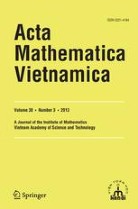
Acta Mathematica Vietnamica
- Volume 50
- Volume 49
- Volume 48
- Volume 47
- Volume 46
- Volume 45
- Volume 44
- Volume 43
- Volume 42
- Volume 41
- Volume 40
- Volume 39
- Volume 38
- Volume 37
- Volume 36
- Volume 35
- Volume 34
- Volume 33
- Volume 32
- Volume 31
- Volume 30
- Volume 29
- Volume 28
- Volume 27
- Volume 26
- Volume 25
- Volume 24
- Volume 23
- Volume 22
- Volume 21
- Volume 20
- Volume 19
- Volume 18
- Volume 17
- Volume 16
- Volume 15
- Volume 14
- Volume 13
- Volume 12
- Volume 11
- Volume 10
- Volume 9
- Volume 8
- Volume 7
- Volume 6
- Volume 5
- Volume 4
- Volume 3
- Volume 2
- Volume 1
Eupolars and their Bialternality Grid
Jean Ecalle
Abstract
This monograph is almost entirely devoted to the flexion structure generated by a flexion unit $\mathfrak{E}$ or the conjugate unit $\mathfrak{O}$, with special emphasis on the polar specialization of the units ({``eupolar structure''}).
(i) We first state and prove the main facts (some of them new) about the central pairs of {bisymmetrals} $\mathrm{pal^\bullet/pil^\bullet}$ and $\mathrm{par^\bullet/pir^\bullet}$ and their even/odd factors, by relating these to four remarkable series of {alternals} $\{\mathfrak{re}_r^\bullet\}$, $\{\mathfrak{le}_r^\bullet\}$, $\{\mathfrak{he}_r^\bullet\}$, $\{\mathfrak{ke}_{2r}^\bullet\}$, and that too in a way that treats the swappees $\mathrm{pal}^\bullet$ and $\mathrm{pil}^\bullet$ (resp. $\mathrm{par}^\bullet$ and $\mathrm{pir}^\bullet$) as they should be treated, i.e. on a strictly equal footing.
(ii) Next, we derive from the central bisymmetrals two series of {bialternals}, distinct yet partially (and rather mysteriously) related.
(iii) Then, as a first step towards a complete description of the eupolar structure, we introduce the notion of {bialternality grid} and present some facts and conjectures suggested by our (still ongoing) computations.
(iv) Lastly, two complementary sections have been added, to show which features of the eupolar structure survive, change form or altogether diappear when one moves on to the next two cases in order of importance: eutrigonometric and polynomial.


